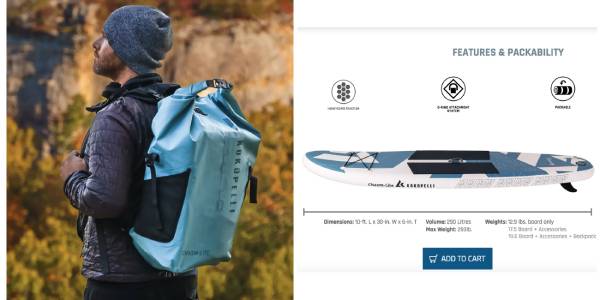First off, some honest introspection is required. Can your furry friend handle being in a kayak?
If you’re not careful, you won’t be able to get your dog comfortable with the sights, sounds, and feeling of being on top of the water.
Is your dog a strong swimmer?
If yes, that’s certainly helpful. If you don’t have a doggie-PFD, it’s not a big deal, but you will absolutely need one. A dog who is a strong swimmer is still best off wearing a life jacket.
can your dog be trained for kayak life?
There are many things to discover both in the water and on land. Sticks, frogs, ducks, whales, other dogs on other kayaks. The list is deliriously long.
Does your dog have the self-control to resist the urge to investigate something that catches their attention?
If your dog does not have anxiety, can manage their impulses, and can be trained to behave safely, you may have a great kayaking experience together.
Get Your Dog Used to Kayak ‘Things’
The first step in preparing your dog to come kayaking with you is to do some training on land.
A kayak is a large, colorful, unstable, and loud boat-like object that confuses not only dogs, but also humans.
You will need to spend some time getting your dog used to the kayak before taking it out on the water.
Plastic kayaks can be slippery
The first step your dog takes into a kayak may be a difficult one. If you’re kayaking with your dog, be sure their nails are trimmed so they don’t slip on the hull.
Encourage your dog and give him praise as he gets used to walking on this new surface.
Make sure to give your dog a treat whenever they do something you want them to do while you’re both in the kayak.
A towel or mat placed in your boat may help your dog feel more comfortable and confident taking his first steps in.
Kayaks are tippy
The amount your kayak tips over is generally determined by how stable it is.
When you first get in a kayak, you might feel like it’s going to tip over. That’s because it’s primary stability is its initial tippiness. Flatter hulls create higher primary stability and less initial tippiness.
This refers to how stable your kayak is when it is hit by waves and swells.
Kayaks that are primarily designed for stability are usually intended to be used in calm water. If you are paddling in moving water, your kayak may become more tippy and difficult to control.
Your dog will be nervous at first when they try to get used to the instability of your kayak. This means that your dog’s movement will make the kayak unstable and more likely to tip over.
Think about letting your dog see your kayak rocking on land before you get in the water. Reinforce his attention with rewards and treats.
When you are comfortable with the boat rocking, invite your dog into the boat to learn to sit or lie down while the boat is still on land. Again, positive reinforcement is helpful.
After your dog is okay with being in the kayak while it’s moving, you can take it out on the water.
Teach Your Dog Where to Sit / Lie Down in Your Kayak
Your dog will need a safe and comfortable place to stay in your kayak. Where your dog should sit in your kayak is determined by both the size of your dog and the style of kayak you paddle.
A sit-on-top kayak has more surfaces for your dog to sit and lie down on. Although it may not seem like it, your dog will move around the boat as you paddle. Sometimes, she will come to you, and other times, she will stare off into the distance, thinking about life’s mysteries.
If you paddle a sit-in kayak, bringing your furry buddy along is not an option. A kayak with a big cockpit is necessary if you want to be able to bring your dog along with you. There needs to be enough room for both of you to move around and for your paddle so you don’t accidentally hit your friend in the head.
Find a spot in your kayak that will keep the weight balanced and put a towel there that your dog can use as a comfortable “home.” As she sits and lies down on the towel, reinforce desired behaviour.
Think about how getting the inside of the kayak wet might affect your dog. If you’re having trouble with a wet towel, try packing an extra dry one in a dry-sack.
Pet-owning kayakers sometimes line the floor of their kayaks with towels or yoga mats. This allows your pet to move around without slipping. This means that your dog will have more opportunities to move around, which can be good or bad depending on the situation. Your call.
Get Your Dog Used to Your Paddling
First, this is primarily an on-land task. Do this with your dog in the kayak so that they can get used to the motion of paddling. Your dog is likely to be instinctually scared of a paddle flying around overhead. He’ll learn that a paddle that is moving isn’t dangerous over time.
The next step is to move to the water. Paddling creates noises that your dog isn’t used to. Make sure your dog gets used to the sounds of water before taking him paddling. Sounds that may bother us can actually become soothing to our dogs.
Here Is The Step By Step Process Of Kayaking With Your Dog
Step One: Find A Dog-Friendly Kayak And Prepare It
We all know how much dogs enjoy going on a paddle. There’s nothing like spending time with your dog, whether you’re relaxing on the water or hiking through the wilderness. An increasing number of people are taking their pets with them on water-based adventures.
If you and your pet are in the middle of nowhere and your pet is getting thirsty, what do you do?
Step two: Introduce The Dog To The Kayak
To get your dog used to the kayak, start by putting one paw in the boat. Then, lift it out of the water slowly. If your dog starts to wiggle their paw back in, take their paw out of the water and start from the beginning. Reward them with a treat.
Step three: Get The Dog Used To Paddle
The best way to get your dog used to the water is to get her used to it in your hand. This will help her feel comfortable and less fearful of the water. Fill the sink with warm water and place your hands in the water.
Soak the towel in the water and hold it under your hands. Place the towel on the ground and gently put the dog on the towel. Let the dog walk around on the towel.
She will need some time to adjust, but eventually she will get used to it with a little patience.
Step four: in teaching your dog to fetch on water is to throw a ball for them to fetch.
When playing fetch with your dog in water, he will need to use a specific technique. If you want your dog to go high, you should toss the ball high. If you want your dog to go low, you should toss the ball low.
The right arm should be brought up and then out to the side while the left arm is brought down and then out to the side. To make a low ball, bring your right arm down and then up and out to the side.
Step Five: Get Them To Jump In The Kayak With You
The first step to teaching your dog how to swim is to get a dog that enjoys being in the water. The ideal dog for swimming lessons is one who has no prior experience with water – this way, they’re less likely to develop any bad habits.
A golden retriever is a good breed to start with. Some dogs like swimming in the water, while others might not be interested. The next step is to put a life jacket and special harness on the dog.
The harness will be similar to a seatbelt, and will have a leash attached to it. The leash should be long enough to where you can hold onto it.
What Is The Best Dog-friendly Kayak?
There are three aspects to judge when settling on a kayak that would work best for your pup:
1. A kayak that is stable and tracks well is what you want. A dog is likely to move its head back and forth. A stable kayak won’t tilt despite the movements.
2. A kayak should be spacious so that a pup can relax comfortably next to the owner.
3. Your pal will weigh down your kayaking trip. So, you want a lightweight and inflatable kayak. This type of kayak allows easy paddling when possible.
Satisfying the above 3 points is why Sea Eagle made it to our top recommended brand of kayaks for dogs, with the below kayak being our top pick:
THE SE 370 PRO KAYAK
We recommend the SE 370 Pro as the best kayak for dog-friendly use. This kayak has a lot of pros, and only a few cons. Let’s review them:
1. This kayak is compact and lightweight with a capacity of three people. The removable rear-entry seat makes it easy to get in and out of.
2. This product comes with a carry bag, two seat paddles, and a foot pump. This added convenience makes it easy to take with you wherever you go.
3. Dog friendly Platform, Deck and attachment
4. Skegs for better tracking and speed
5. Anti-scorching& high frequency welded seams
6. This drain valve is perfect for quickly and easily draining your water, as well as for easy transportation.
7. This item can be expanded with up to 5 valves, making it perfect for small rooms or large businesses.
8. This space can comfortably hold two people and two dogs at once, depending on the size of the dogs.
9. It’s a sturdy kayak that can withstand dog claws even if they’re not trimmed.
10. It’s low-cost and versatile.
11. Set up process is easy.
12. This kayak is more stable than other similar kayaks and less likely to capsize on water.
13. The best kayak for families has plenty of space to store all of their belongings.
Various price points are available for dog friendly kayaks. And, usability and price points will be budget-friendly. There are different kayaks to choose from and you can pick one that best suits your needs.
You can then customize it further by choosing from a variety of packages.
Some kayaks aren’t fitting for dogs. Remember to keep the size of the boat in mind when looking to upgrade or purchase your first boat. You also want to find one that will be able to handle the type of water you’ll be paddling in.
You should find a kayak that will be comfortable for both you and your partner to use. The kayak should also be able to handle the type of water conditions you’ll encounter while paddling. The right type of hiking backpack for your dog will depend on the size of your dog and how much gear you plan on carrying.
The position of your dog in the kayak may vary depending on what makes him most comfortable. He could be on the bow where he has more freedom, or he may be more relaxed wedged in by your feet. Consider your dog’s personality when picking one, too.
Nervous dogs might act better if kept close. Additionally, you can grab their collar if needed. A dog that is quiet and likes to sleep would do well staying on the bow. When looking for the best kayak for your dog, you need to consider both the size of your dog and your budget.
If you want to bring someone with you on your trip, the extra space will be perfect for them. I prefer the SE 370 over the Sea Eagle 330 because it is larger and can fit 3 people.
What to Do if Your Dog Jumps Out of the Kayak
If your dog’s impulses are too strong, she may jump out of the kayak.
If anyone falls out of the canoe without permission, paddle towards them and firmly tell them to get back in the boat.
If the woman is wearing a personal floatation device, then you should pull up alongside her and use the handle on the device to help her back onto the boat. Make sure you put your paddle away so that it doesn’t fall out and get lost in the water.
If your dog is not wearing a life jacket, you will have to paddle next to him. You’ll need to put your arm across your dog’s back and hook under its front legs to lift it so it can get back into the kayak.
It is in both of your best interests to remain calm and use a soothing voice, even though you may be feeling frustrated.
Once your dog is back on board, give her a treat for returning back to the kayak and letting you help her get back in the boat.




